A Statistical Study of Belief[1]
Francis B. Sumner
I. INTRODUCTION.
It is a matter of common experience that our beliefs are more or less graded in a scale of certainty. Some of them we cannot conceive of our ever changing ; others, although practically certain, might, conceivably at least, be subject to revision or even reversal, whilst others yet command little authority and even vary. momentarily with the play of our feelings. Nor are these three main ranks of certainty all that can be distinguished. The degree of one's belief, like the intensity of any mental state, admits of an almost indefinite gradation quantitatively. But, unfortunately for our present purpose, it shares with other mental :states the property of defying accurate measurement. The :practical test of belief is, of course, conduct. One can be truly said to believe only what one acts as if he believes, and the gauge of his conviction is the extent to which it is embodied in his actions. Thus, although beliefs defy exact measurement, and a.-re even to a great extent incommensurate, one with the other, their relative strength finds a common standard in their motor results. But even this does not furnish a practicable yardstick to the psychologist. All those things of which we are practically ' sure' are in our daily life absolutely coercive upon conduct. There would be no degrees distinguishable. And this, although to introspection there might be appreciable differences in the intensity or vividness with which they presented themselves to consciousness. Hence, in the present experiments, I have had recourse to the method of introspection, although this is fraught with difficulties so great as perhaps to render the results of little value.
( 617)
II. METHOD.
For my general method of procedure, I am indebted in large degree to the suggestions of Professor Cattell. This method is as follows : I drew up a set of twenty-five questions, ' a sort of shorter catechism of twenty-five articles of faith,' as a friend of mine called it. These questions bore upon a great variety of topics, being intended to touch nearly every general class of subjects upon which the average person forms opinions. Quite as diverse were the degrees of certainty with which the questions might be answered, some being answerable with absolute confidence, some with very little or none.[2] For convenience in performing the experiment, the questions, typewritten, were pasted upon separate cards. The subject was requested to spread the cards out upon a table and arrange the questions in the order of the certainty with which he felt able to answer them, placing the most certain at the top, the least certain at the bottom and the others in a series between. This arrangement was to take no account of whether positive or negative answers were given ; it simply was intended to show the certainty with which the questions were answered, i. e., the degree of one's conviction concerning the subject-matter of each. If two or more questions could, in the subject's opinion, only be answered with exactly the same degree of confidence, they were to be placed upon the same horizontal line. The following illustrates the plan :
D yes, B yes, I yes.
V yes.
N yes, F yes. R yes.
O yes.
A yes, L yes.
U no. K yes, etc.
TABLE I.—THE QUESTIONS EMPLOYED IN THE EXPERIMENT.
A. Is the world becoming better?
B. Are there other human minds besides your own ?
C. Would this continent have become as quickly
civilized if it had remained colonial?
D. Do two plus two equal four?
( 618)
E. Will the death penalty for murder always be held
justifiable among civilized peoples?
F.
Is the earth round?
G. Will our Republic endure another hundred years?
H. Does the present life alone furnish sufficient
motives for moral conduct?
I.
Will the sun rise to-morrow?
J.
Is a protective tariff a wise policy for the United
States?
K. Do any landscape paintings yield as much
satisfaction as the finest natural scenes?
L. Is the evolution of living beings a fact?
M.
Is there life on other heavenly bodies?
N. Did George Washington live?
O. Will the most honest man you know be honest ten
years hence?
P.
Is a man's conduct determined entirely by his
heredity and the circumstances of his life?
Q. Is the scientific mind as truly creative as the
artistic?
R. Does the moon's attraction cause the tides?
S.
Is there an even number of persons in New York
City?
T. Will there be frost in New York City during
September next?
U. Is matter ever created or destroyed?
V. Am I awake at this moment, i. e., not merely
dreaming?
W.
Do spirits of the departed ever communicate with
living persons? (We refer only to modern times.)
X. Will poetry always be held in high regard by the
most cultivated minds?
Y. Would a college education be, on the whole, an
advantage to the majority of young men ?
III. DIFFICULTIES.
As I had expected, the experiment was attended with great difficulties. No list of questions of this sort can be constructed which is free from ambiguities. A paragraph of explanation for each one would be impossible practically, but would be necessary to an adequate understanding of the intended meaning.
A second difficulty is to be found in the impossibility of altogether distinguishing one's subjective feeling of sureness from the logical certainty of the thing believed in. The two are by no means always proportional, and of course it is the former that we wish to record. In one's despair at not being able to lay hold of the elusive belief itself, one is strongly tempted to go back to the data upon which it is based and to deal with them rationally. But if there is one thing which the student of this subject is impressed with it is with how small a fraction of our beliefs arise in the first instance through reason or, having arisen, are maintained by it. One believes most vividly what
( 619) appeals to one's interest most strongly, although to cold reflection the thing believed in may take a low place in the scale of certainty.
A third difficulty in the way of our study we have already alluded to, i. e., the incommensurability of beliefs concerning widely different classes of things. Many of my subjects have complained with justice that their beliefs upon the matters in hand varied not only in quantity but in quality. As we have seen, there is a common standard of measurement in action, but such a test is here impracticable. So that the above difficulty is a serious one. I have, myself, tried with some measure of success the expedient of imagining my degree of surprise upon learning that the beliefs in question were false.
Yet another obstacle we have to deal with is the fluctuating and temporary
nature of any arrangement we may make with the questions. A given belief rises
or falls in the scale of certainty according to the momentary state of our
mind's contents. The chance intrusion of a new idea may lead us to make a
whole-sale rearrangement of our order. Merely fixing one's attention upon any
member of the series tends to raise its relative position. This vacillation
diminishes, however, with further reflection upon the task, and one may succeed
at last in giving what he feels is a fair record of his mean attitude towards
the set as a whole.
IV. RESULTS.
1. General.—In all I obtained about one hundred and thirty records of this experiment. Of these, about thirty were defective, owing to carelessness or to misunderstanding of my purpose. I selected for study the hundred records which seemed to be most carefully made out.
In my work of securing subjects, I was aided very materially by several friends, whose labors secured me many records. My acknowledgments are especially due to Messrs. Paulmier, Holmes and Strong, of the Department of Zoology at Columbia; to Professor C. J. Herrick, of Denison University, and to Miss M. W. Calkins, of Wellesley. I wish also to record here my profound thanks to Professors Russell and Prettyman, of the Teachers College, New York, and to Professor Maria L.
( 620) Sanford, of the University of Minnesota, for allowing me to perform my second test [3] upon scholars and students in their respective institutions.
The average time devoted to the [first] experiment by each subject was about three-quarters of an hour.
Of the hundred whose records were studied, forty-two stated that their arrangement of the questions was satisfactory to themselves, twenty-four that it was fairly satisfactory, while twenty-four stated that it was unsatisfactory.
In a large proportion of cases the letters [2] were all arranged serially, in many others, on the contrary, certain ones were grouped together and given co÷rdinate value. The lowest number of degrees of certainty discriminated was four, the average was a little over nineteen.
In the computation of averages, my procedure was as follows : The position assigned to every letter by each of the subjects was tabulated and the average taken. For example, if question A was given twelfth place in one subject's column, sixteenth place in another and eleventh in a third, the average position of A, for the three records, would be 13.
In cases where several letters were given co÷rdinate value, the matter was a little complicated. A letter having tenth place in a series of 13 grades would clearly have a different value from one having tenth place in a series of 25 grades. Some method was necessary by which two such discrepant series could be reduced to common terms. Take the case of one having 13 grades or degrees of certainty. The first and last of these I denoted 1 and 25 as in the 25-grade series. But in the former case there are 12 intervals, in the latter 24. Accordingly I doubled each interval. 1, 2, 3 . . . . etc., to 13 became 1, 3, 5 . . . . etc., to 25. Thus it was possible to compute the average position of each letter for all the records.
Table II. gives the average position of each letter for the hundred subjects. D takes first place. If it had been given first place unanimously by all the subjects, its position in the
( 621) average series would be 1. But by many it was given second or even a lower place. S by unanimous verdict[5] takes last place and its position is accordingly 25. Many subjects considered other questions—e. g., T and M—to be as unanswerable as S and made them co÷rdinate with it, but those letters were given a higher place in most records and therefore their average position is higher.
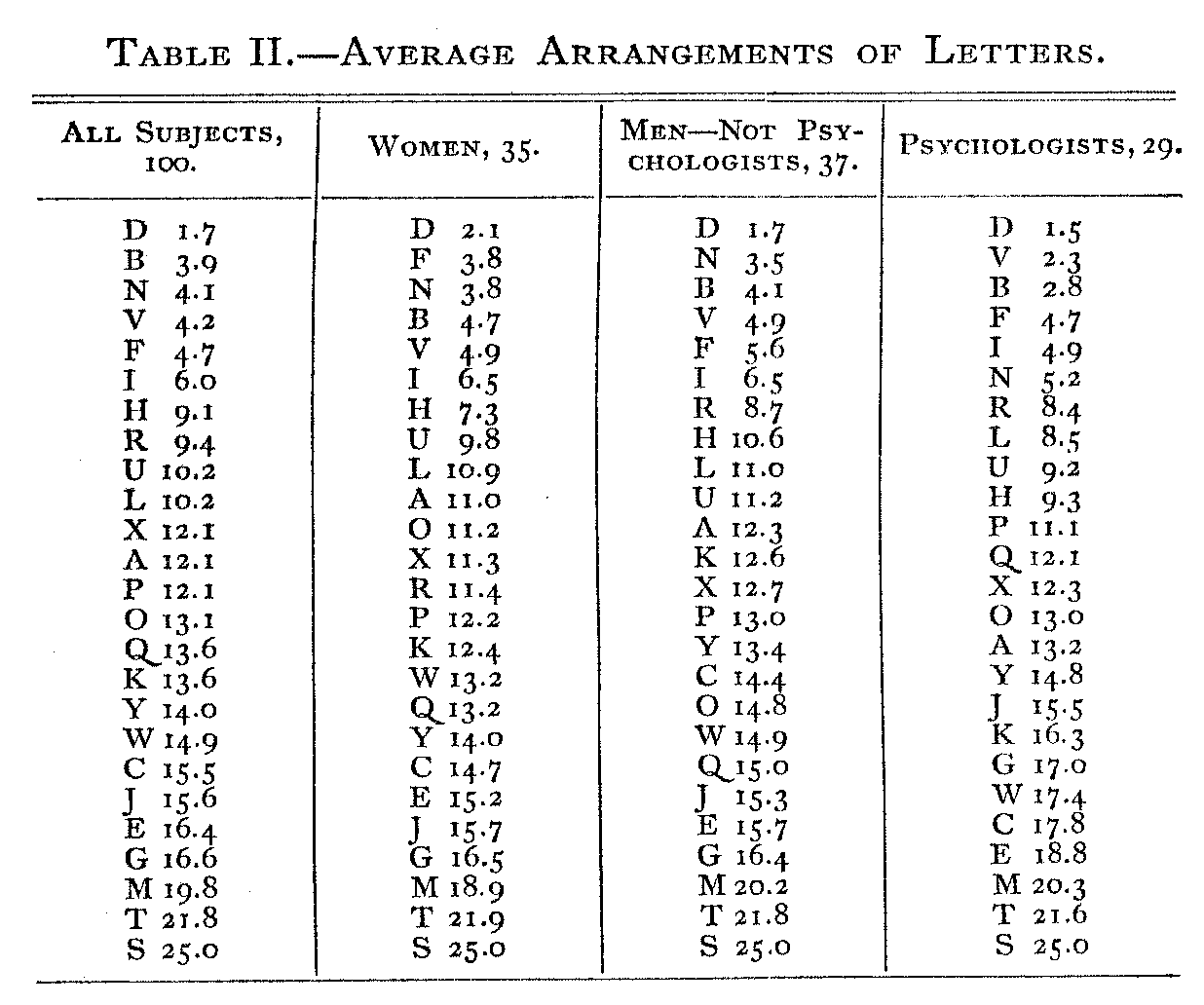
Table II. (first column) exhibits, then, the average arrangement of the twenty-five questions by a hundred educated per-sons, most of whom, I am convinced, performed the experiment with care. Obvious at a glance is the fact that the intervals are not equal. D (1.7) is followed by B (3.9), but H (9.i) is followed by R (9.4). The relative spacing of the members of the series is best shown graphically (Chart I., a). It will be seen that the members of the series are arranged in three main groups.
( 622) The first (D, B, N, V, F, I) can be seen by reference to Table I. to be propositions having the certainty of axioms. Of the last group (M, T, S) M and T admit of little more than guesses,
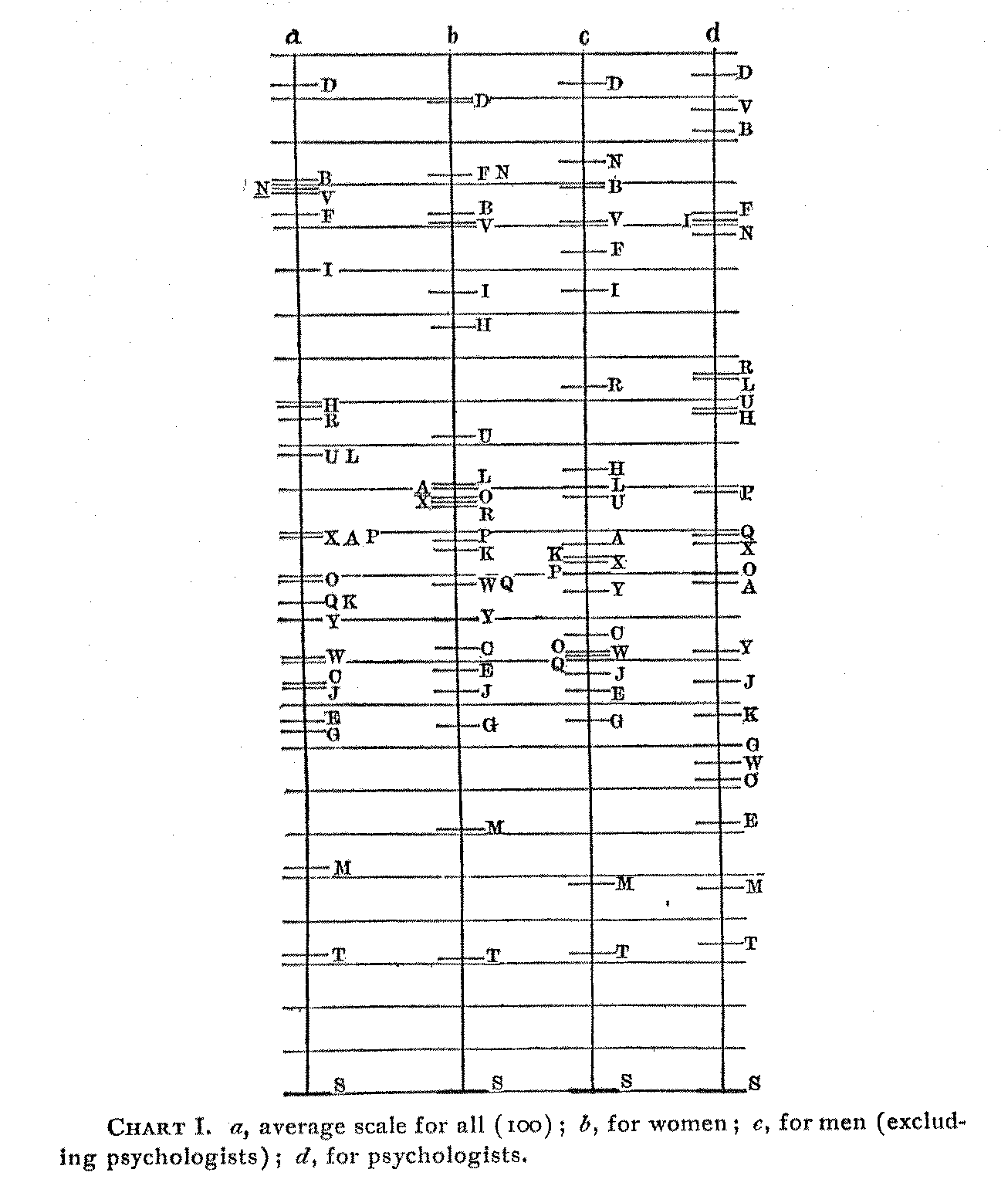
while S is unanswerable by any human intelligence. The remainder of the letters—two-thirds in all—occupy but a third of the length of the column. The distances from I to H on the one hand and from G to M on the other, are seen to be very
( 623) great. The intervals within this group, however, are some of them very small, while three letters (X, A and P) occupy the same place in the scale as do also U and L, Q and K. For further understanding of the chart the reader is referred to Table I., where the meanings of the letters are given.
2. Variations.—An average is of little value, however, without a knowledge of the extent of variation among the numbers averaged. Table III. gives the average variation for each letter. Thus that of A is for the hundred subjects 4.7. This is the average departure of the A's in all the hundred records from the average A (=12.1). The average variation for all the letters is 4. This certainly shows a high degree of divergence among the records of the various subjects. If the aver-age variation of a given letter (M, for example) is q, this signifies that only a half of the M's of our subjects would fall within an interval of eight places in the series or a third of the length of the column.
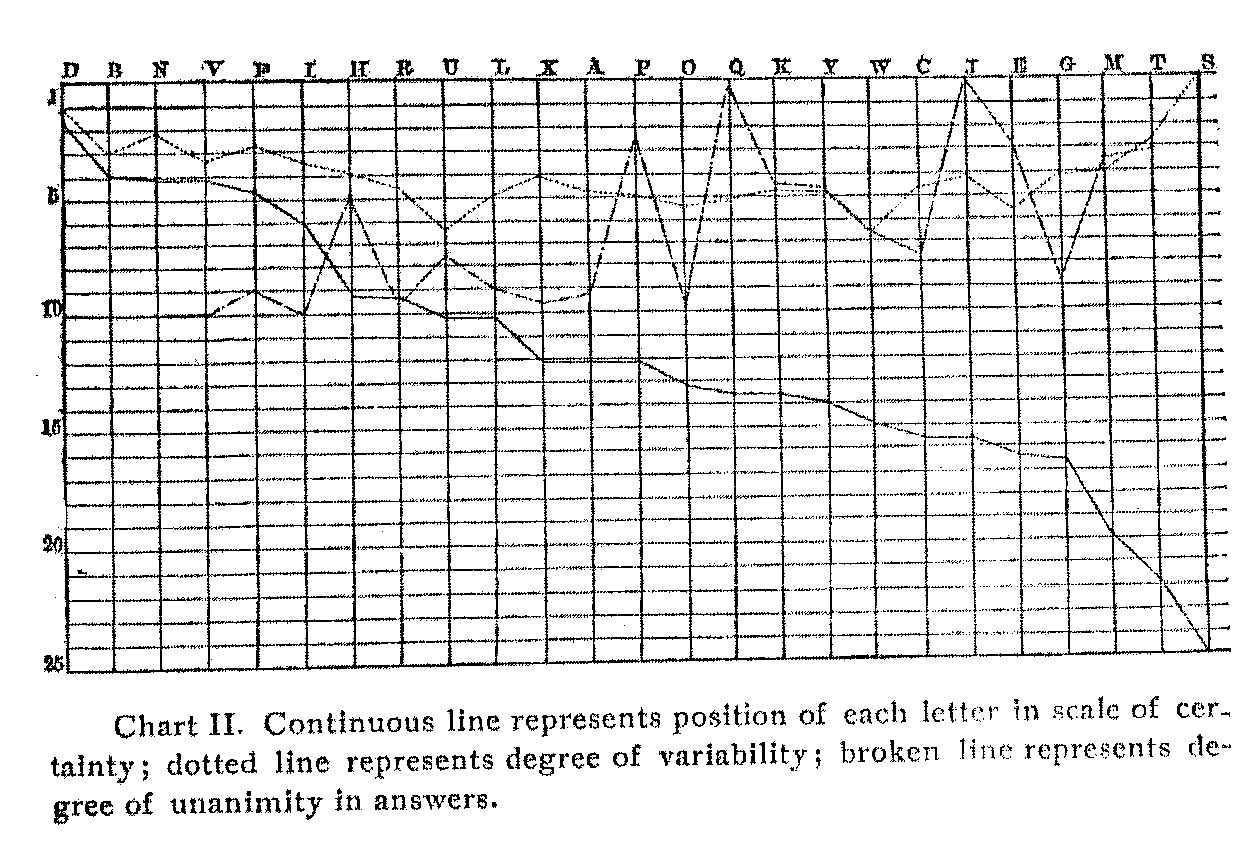
The letters near each end of the series shoe- ;i much lower variability than those in the central region. Except for this general relation, there seems to be no connection between variability and grade of certainty. W and U are the most variable
( 624) letters, E and O are next in order. The dotted line in Chart II. shows the variability of each letter, the unbroken line representing the position of each in the scale of certainty.
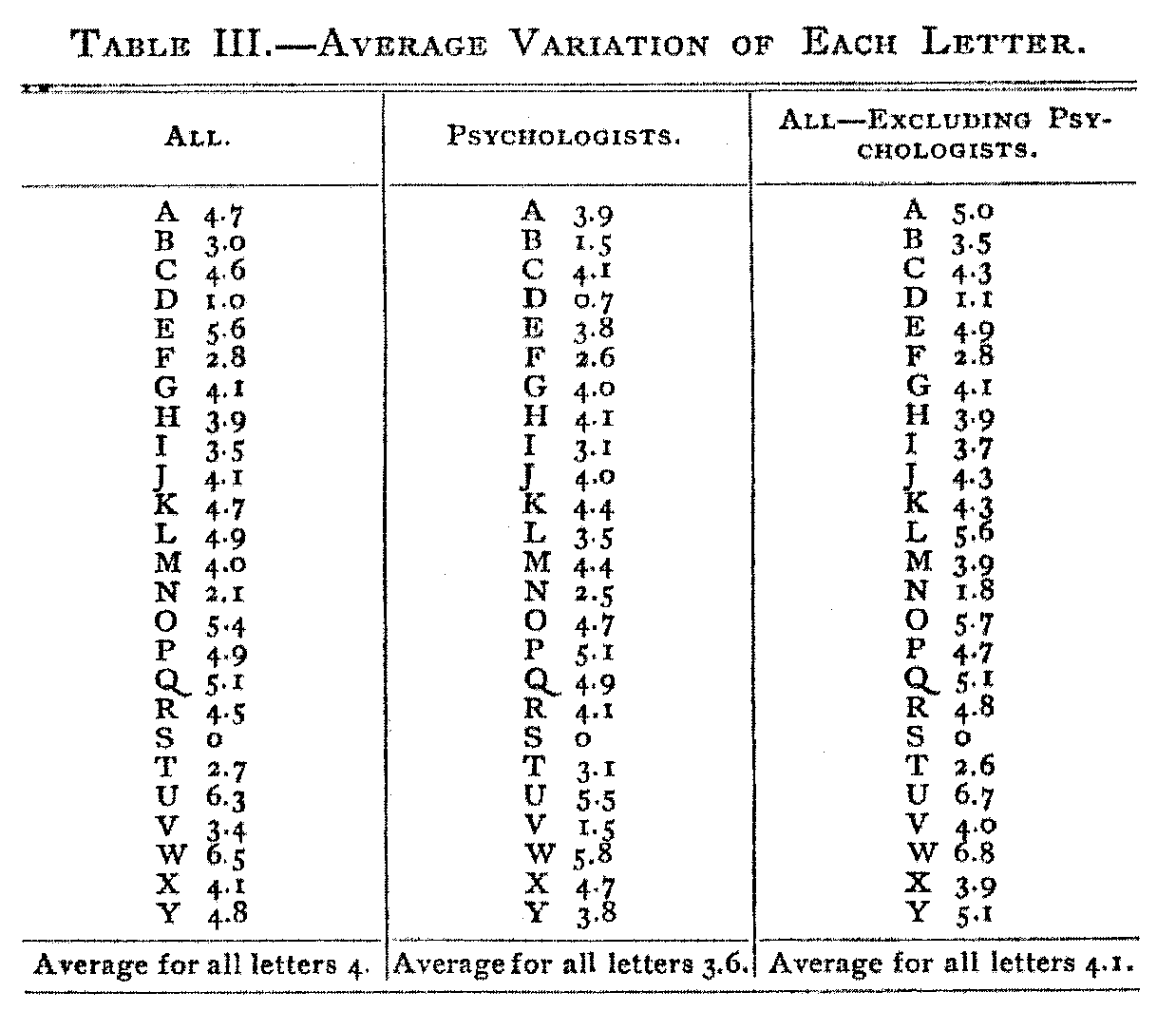
3. Answers Positive and Negative.—Table IV. gives the answers positive and negative to the various questions. Only the ' totals' need concern us at present. In the ' no opinion' column are tabulated those cases where questions were given the rank of 25, i. e., placed upon a par with S. Something of an analysis of this table will be given later. The degree of unanimity in the replies to a given question is measured by the difference between the number of positive and negative answers. The greater the unanimity, the greater, of course, is this difference. In Chart II. the broken line indicates the degree of unanimity. On the first six questions, of course all are agreed, the negative answers to F (" Is the earth round?") being doubt-less due to a wrong interpretation of the word ' round.' One
( 625) would, perhaps, be at first inclined to expect the degree of unanimity to be represented in this chart by a descending curve of reasonable uniformity ; in other words, that there would be most disagreement in answering those questions upon which our opinions are least firm. But this is by no means the case. Upon H, which stands seventh in the series, there is more division of opinion than upon half of the questions which follow it, while G, which is answered ' yes' almost unanimously, stands fourth from the last in the order of certainty. Compare, also, P and Q with C and G.
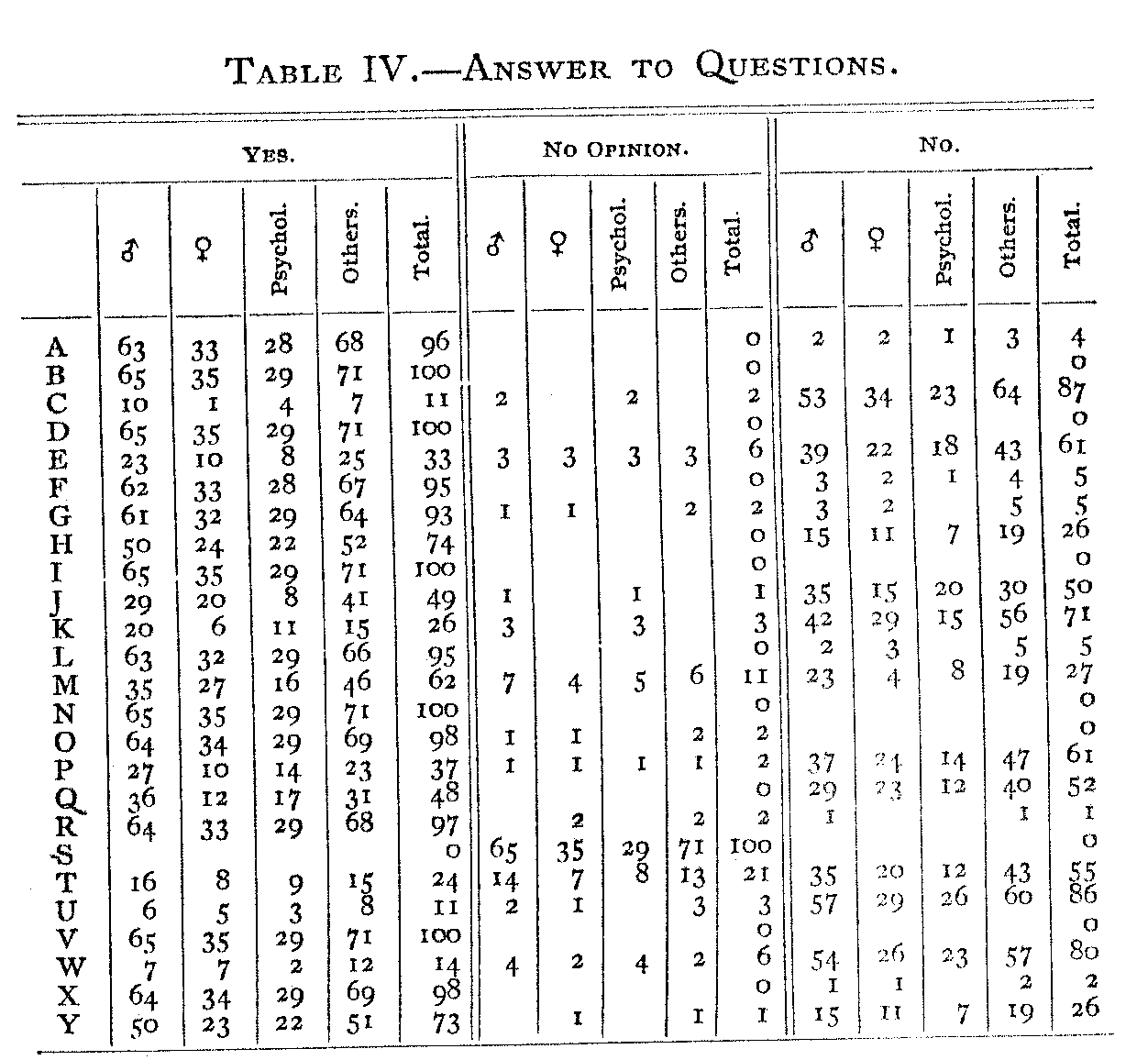
There would thus seem to be beliefs which nearly all of us hold, but which we hold with far less certainty than we do some other beliefs concerning which there is much disagreement. The speculative nature of its subject matter or its remoteness in time or space may give to one of our beliefs a low degree of intensity
( 626) while our possession of the same data or the same prejudices may lead us, nevertheless, to hold it unanimously (A, O, C, G). On the other hand, much of the disagreement in the answers to some of the questions (e.g., H, P, Q) is probably more apparent than real, being due to a misunderstanding of the intended meaning of the words.
Another relation of interest between the character of the answer and the position of the question is to be found in the fact that, in nearly all cases where there was a marked difference between the number of positive and negative replies to a given question, those siding with the majority expressed their conviction with a considerably higher degree of certainty than those siding with the minority. In Table V. these letters are given, with the average position in the series assigned to them by those answering ' yes' and ' no,' respectively. That reply is italicized in each case which was given by the majority of subjects.

4. Arrangement of Series in Relation to Sex.—My subjects numbered 35 women and 65 men, but, as only one of the women was a special worker in psychology, it seemed fairer to compare the women not with the men as a whole, but with the men excluding the psychologists. Thus the sexes could be compared free from other complications. As we shall see later, the training of the special students in psychology led them to depart more from the untrained of both sexes than the latter did from one another. In Chart I., b is the average series for the women, c that for the men, excluding psychologists, numbering 37. As will be seen from the chart, the following letters are given a higher position by the women than by the men, only difference of -iv or over being counted : F, H, U, A, O, X, P, W, Q, E, M. The letters given a higher position by the men than by
( 627) the women are : D, B, R, Y, J. It is interesting to note that the former list contains the only five questions out of the twenty-five having an ethical or religious import, namely : H, A, O, P and E. The position given to a question in the scale of certainty is an index of the force with which it appeals to one's interest. Thus, also, Y and J are questions which one would expect to interest men more than women. The higher position given to D and B by the men points to the latter having given a more careful consideration to the task of arranging the questions, for only a thoughtless person would place either D or B much below the top of the series, and this was evidently done by a greater proportion of women than of men. R on the men's side finds its counterpart in F on the women's. This position can have no special significance in either case.
Considering the number of positive and negative replies in relation to sex, we find from Table IV. that C, E, H, K, P and Y are given a considerably greater proportion of negative answers by women than by men,[6] while M, U and W are given a greater proportion of positive answers. For the other questions, there is little if any difference to be found in the proportion of answers given by the two sexes. The condition in regard to E, H, P, Y and W is perhaps as we should expect ; the case of the other letters is less intelligible.
5. Scale as Arranged by Special Students of Psychology.—Scale d in Chart I. represents the average arrangement of the questions by the 29 instructors and special students in psychology. A glance shows that this scale differs widely from a, b or c, and differs from all of them on a point on which they agree with one another. The letters are more widely and uniformly distributed throughout the column. There is less concentration at the middle. Such concentration in a, b and c results from each of the letters so affected having been subject to wide variation up and down the column, so that in the average they all tend to fall into a mean position in the series. It indicates that a larger part has been played by chance in the arrangement of the questions. Thus there seems to be a greater approach to unanimity among that group of my subjects who
( 628) were best qualified to perform the experiment satisfactorily. We shall find further proof of this below.
The scale representing the psychologists' records differs more from that of the other men and the women than these do from one another. The average difference of each letter in the former case is 1.4, the latter (men and women) differing from one another by an average of only I.
In the psychologists' scale we find the following letters given a higher position than in that of the other men (only differences of 4/10 or over being counted) : V, B, F, I, L, U, H, P, Q,, X, O. The following are given a higher position by the other men : N, A, K, Y, C, W, E, G.
V and B naturally appeal to the psychologist, the first dealing with one's own state of consciousness, the second with the existence of other minds. L and U deal with scientific hypotheses, while H, P and Q are problems of philosophy. X concerns the future development of the human mind. F, I and O do not seem especially to belong here, except, perhaps, for the reason alluded to in the preceding section for the position of D and B.
In the second list, N, Y, C, E and G are concerned with data of a more practical and tangible sort, N, C and G being largely founded on historical evidence and Y upon the direct experience and observation of many men.
For the answers ' yes' and ' no' given by this group of subjects, the reader is referred to Table IV.
It is significant that the variability in position of most of the letters is considerably less for the psychologists' series than for the others. The average variation of all the letters is for the former 3.6, for the latter 4.1 (Table III.). Here, then, is further illustration of the fact that those subjects who gave the matter most careful study have arrived more nearly at a standard arrangement of their beliefs. This is strong evidence that the great differences which we observe in the order given by different men are due not so much to actual differences of belief as to imperfect introspection.
6. A Second Trial Made by the Same Subjects.—This was done by nine of my subjects. The second trial was made, on the average, twenty-four weeks after the first. In the cases
( 629) where I interrogated the subjects, they denied emphatically having been consciously influenced by their first performance of the test. My object was to determine how much stability there was in this attempted gradation of one's beliefs and how much was merely due to caprice. The result of the test was most gratifying. The average departure in position of each letter in the second trial from that in the first was only 2.3. As we learned above, the average departure of all the letters in each man's arrangement from the general average of all other men was 4.
V. A LATER EXPERIMENT.
The length of the series of twenty-five questions rendered the performance of the experiment rather a long task. Again, the nature of most of the questions made it an impossible test for children. Accordingly I selected from the former set five of a very simple nature (A, N, O, V, Y) converted them into propositions and directed my subjects to arrange these in their order of certainty. Thus :
A [O] The most honest man I know will be honest ten years from now.
B [V] I am awake at this moment, that is, I am not merely dreaming.
C [A] The people of the world are becoming better.
D [Y] It would benefit the majority of young men to attend college.
E [N] George Washington was a real person.
My subjects ranged in age from fourth-grade pupils to college seniors. I received over two hundred records, of which I found it possible to utilize 187. To simplify computation I rejected those papers, forming a small proportion of the whole, in which any two questions were given co÷rdinate rank. In presenting the results I have divided the subjects into two groups. The first includes the college students, 84 in number, with an average age of a little over 21 years. The second includes the grammar and high-school pupils, 103 in number, with an average age of a little over twelve years.
Table VI. gives the average arrangement of the series by all the subjects, also by sexes and by groups. Along with
( 630) them I have indicated for comparison the rank of the same five letters in the first experiment.
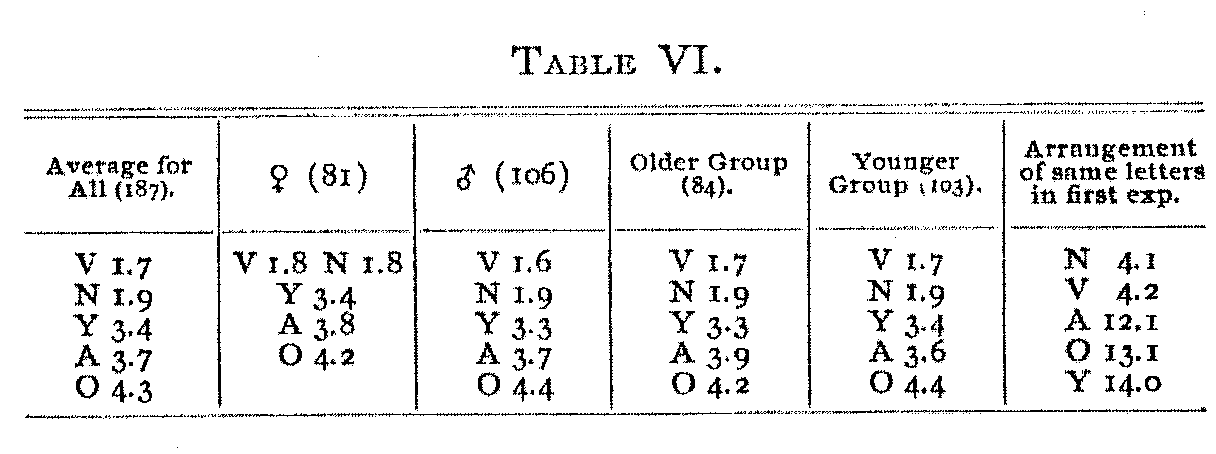
It will be seen at once that the grading given in my second test does not agree with that in my first. Again, it will be noticed that the older and the younger groups have given the same order of arrangement and also that the boys and the girls have given the same order except for the latter making the first two propositions coordinate. Here we find a greater constancy than in the first experiment. Table II. shows at once that, of the three groups of subjects recorded, no two agree as to the relative position of the five letters under consideration. Doubtless the greater simplicity of the second experiment is accountable for this difference.
VI. SUMMARY.
Our results, then, are, in brief, as follows :
I.Two-thirds of my subjects (in the first experiment) considered it possible to arrange their beliefs in a graded series which was fairly satisfactory to themselves at the time.
II. On comparing the average arrangement of the questions for men and women, certain differences appeared which seemed to be characteristic of the two sexes.
III. Even more characteristic differences were found on comparing the arrangement made by the trained psychologists with that by those who had had no special training in this subject. The former were found to have made a much closer approach to a standard order of arrangement than the latter. This implies that a great deal of the recorded difference of belief was due to defective introspection. The subjects have re-
(631) -corded, not what they believe, but what they think they believe, and, of course, the trained psychologists have been better qualified than the others to discover what their true beliefs are.
IV. A second trial was made with some of the same subjects after time enough had elapsed to allow of their forgetting their first results. This afforded further evidence that a graded arrangement of one's beliefs may be made which is not merely due to caprice, but represents something real.